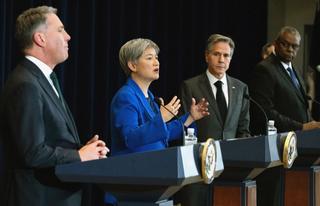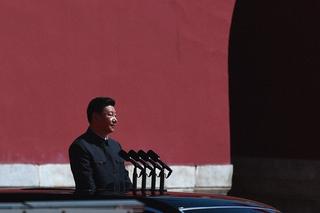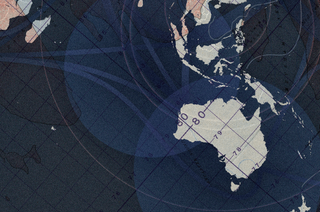“Statecraft also requires the utilisation of all elements of national power… [including] a consistent strategic narrative.”2023 Defence Strategic Review
In recent decades, the strategic security landscape has been rapidly redefined. The information environment — the intangible space where information is created, disseminated, shared and stored between users, whether they be individuals, organisations, governments or machines — is now a battlefield of competing discursive frames.
This shifting landscape allows state actors and non-state actors alike to create and disseminate narratives — including those fact-adjacent — at unprecedented speed and scale.
Achieving advantage in this dynamic strategic environment is increasingly tied to the use of non-kinetic, information-based instruments. The practice of statecraft has evolved from a focus on “state-to-state diplomacy”1 and “state-led public diplomacy”2 to acknowledge that these alone are insufficient to effectively retain influence and build soft power. Instead, “all tools3 of statecraft” must be leveraged. As recognised in Australia’s 2023 Defence Strategic Review, this includes the dissemination and defence of a consistent strategic narrative.
Yet the operationalisation of this narrative — via a distinct Strategic Communications capability — remains in its infancy in Australia. Comparatively, other states — including competitors — have understood the necessity of such investment in the evolving threat landscape, enhancing their ability to actively shape the information environment through dissemination of their preferred narratives.
Australia is vulnerable to being sidelined in the regional contest for narrative control — struggling to adequately counter adverse influence.
As a result, Australia is vulnerable to being sidelined in the regional contest for narrative control — struggling to adequately counter adverse influence. To effectively compete, the Australian Government must urgently recognise this new status quo and articulate a vision for how it will operate — and protect its national interests — in this evolving landscape. As communications increasingly emerge as a vector for geopolitical and security influence, Australia must consider the need for establishing a dedicated, whole-of-government Strategic Communications capability.
As such, this explainer aims to define Strategic Communications within an Australian context, articulate the importance of a Strategic Communications capability in supporting Australia’s position in the Indo-Pacific and recommend potential pathways toward establishing this capability. In doing so, we aim to contribute to discussion — led by the Asia-Pacific Development, Diplomacy and Defence Dialogue (AP4D) and the Australian Strategic Policy Institute — on the urgent need for information capabilities to be incorporated into Australia’s national security posture.
What is ‘Strategic Communications’?
Strategic Communications is itself a contested term. For the purpose of this explainer, we reflect the current understanding of Australia’s closest allies and Five Eyes partners, which tend to define Strategic Communications in similar terms. Strategic Communications has thus been defined by the UK National Security Council as “the systematic and coordinated use of all means of communication to deliver national objectives by influencing attitudes and behaviours.”4

Strategic narratives
To understand how Strategic Communications is used within statecraft, a foundation in strategic narratives is needed. While interrelated, the two concepts must not be confused for one another. Rather, Strategic Communications are directly informed by ‘strategic narratives’.
Strategic narratives define an actor’s self-perception — “who we are” — and interests and objectives — in the case of states, “what kind of world order we want”. Leveraging the power of stories, narratives enable abstract ideas to become tangible and therefore these ideas to be embedded into our collective memory. For example, the oft-cited phrase of ‘free and open Indo-Pacific’, represents Australian and like-minded countries’ interest in maintaining a multilateral rules-based order and refutes the territorial expansion of any one country within the region. Most notably, it implies the existence of a plot, protagonists, antagonists and problems to be solved, providing a lens via which audiences can readily observe, identify and object to disruptive or rule-breaking behaviour.
Narratives are an effective tool of influence when leveraged in statecraft — providing a timeless and accessible way of thinking and feeling about events as they occur, that corresponds to the audience’s pre-existing ideas and understanding of the world. They subsequently provide necessary coherence and direction to Strategic Communications activities and capabilities.
Current conceptions of Strategic Communications
Significant ambiguity exists around the concept of Strategic Communications, with the term often used as a catch-all term for general communications disseminated by both public agencies and private sector organisations. This has led to the existence of various fit-for-purpose governmental, commercial and academic definitions and contributed to confusion and misunderstanding.
For this explainer, we articulate three foundational conditions defining Strategic Communications: the pursuit of clear objectives, designed for influence and using systemic coordination.
- To demonstrate their ‘Strategic’ nature, Strategic Communications activity must be guided by the pursuit of ‘objectives’ — namely the development, dissemination, maintenance and defence of a consistent strategic narrative. Strategic Communications are not purely ‘messaging activities’ that explain intentions or actions. Rather, they are a means of “achieving the required ends of national strategy” by leveraging the narrative power of words and actions.
- ‘Influence’ is central to Strategic Communications. When organisations, state and non-state actors employ Strategic Communications to communicate with audiences, they are not merely concerned with the simple “passage of information.” Rather, they seek to influence the attitudes and behaviours of specific audiences by deploying methods of persuasion. The use of such influence, however, is critically different for democratic societies. While adversaries leverage communications for deceptive gains and disguise communications as harmful propaganda, democratic use of Strategic Communications must be truthful and aligned with democratic values. This includes transparency of decision-making and effective checks and balances in place.
- Strategic Communications should involve the ‘systematic and coordinated use of all means of communication’. This recognises that communication does not occur solely via the written word or is received passively, but can incorporate a wide range of activities and capabilities. By nature, this also allows for flexibility in the use and integration of these activities and capabilities (from public affairs and public diplomacy to information operations), enabling one or more tools to be prioritised at any given point in time based on the contextual environment and overarching objectives. It also highlights the need for Strategic Communications to be thought of as a whole-of-government effort — involving cross-departmental planning, coordination and organisation. Thus, while a variety of communicative products can and should feed into a Strategic Communications campaign, high-level coordination efforts should anticipate and actively plan for the alignment and coherence of these products.
For this explainer, the definitions in the glossary below should be referenced. However, as we later recommend, an Australian Government-specific definition should be tailored to Australia’s specific needs within the Indo-Pacific.
Glossary of key terms
- Information Environment: The socio-political space in which information is created, stored and exchanged between individuals, organisations and governments. Information can be in the form of data, knowledge and intelligence; exchanges can be between humans, humans and non-humans, machines and humans, and machine-to-machine.
- Strategic Communications: The systematic and coordinated use of all means of communication to deliver national objectives by influencing attitudes and behaviours.
- Public Diplomacy: State-led efforts to promote national interests through direct outreach and communication with foreign publics.
- Information Operations: Coordinated information activities, typically involving the production and dissemination of targeted information, designed to affect the willingness, understanding and capabilities of adversaries to act in particular ways.
- Psychological Operations: Coordinated communications activities designed to influence an audience’s perceptions, attitudes and behaviour to support the achievement of program-specific objectives.
- Public Affairs: Public-facing media engagement designed to inform audiences of policies, operations and activities.
- Statecraft: The marshalling and synchronising of all elements of national power to achieve national goals.
Australia’s vulnerabilities
Problem Statement:
Australia faces an increasingly competitive and information-centric strategic environment in its ‘near neighbourhood’ with a deficit in its “readiness to influence and shape the information environment actively.”
Australia’s Minister for Foreign Affairs, Senator the Hon Penny Wong, describes Australia as being in a “state of permanent contest in the Pacific” amid heightened strategic competition. This comment recognises that regional powers, notably the People’s Republic of China (PRC), are making significant inroads in the region — expanding influence through targeted diplomatic, economic and cultural outreach. While discussion of Chinese power in the Indo-Pacific often assumes that material power directly translates to influence, it is critically important to also account for the ways in which the PRC leverages strategic narrative as a means of influence to “modify or (re)shape the values, attitudes, norms, and preferences” of a targeted population.
To this end, the PRC controls an extensive and well-funded global influence network that allows it to actively project its preferred narratives to key overseas audiences.
To this end, the PRC controls an extensive and well-funded global influence network that allows it to actively project its preferred narratives to key overseas audiences. Critically, these ‘preferred’ narratives often run counter to Australia’s national interests, seeking to damage perceptions of Australia (and the United States) and, in turn, bolster the PRC’s position in the region.

In the regional contest for narrative control, Australia is vulnerable. In the Solomon Islands, for example, information-centric efforts to undermine regional relationships with Australia (and the United States) have been well-documented by researchers with the Australian Strategic Policy Institute (ASPI). This includes the use of state media sources, articles published in local media and other sources of content to accuse Australia, the United States and Taiwan of foreign interference, instigation of unrest and “bullying.”
- November 2021:
Following unrest in Honiara, which developed out of initially peaceful demonstrations against the Solomon Islands Government’s 2019 decision to switch diplomatic recognition from Taiwan to the PRC, there was a concerted effort to implicate Australia, the United States and Taiwan as instigators of unrest. This unfounded narrative was projected by PRC state media sources. The Global Times, for example, published content claiming that “Australia has fomented riots in the Solomon Islands” and suggesting that the deployment of Australian police and defence personnel to assist local police during the unrest was orchestrated by the United States, and thus, akin to “blatant military intervention.” Simultaneously, narratives accusing “foreign forces with ulterior motives” of undermining the Solomon Islands-PRC relationship were seeded through PRC official-led articles published in local media. - May 2022:
Efforts to undermine perceptions of Australia continued after a draft of the Solomon Islands-PRC security agreement was leaked in May 2022. Various PRC sources disseminated content condemning Australia’s response to the draft security agreement, arguing Australia was interfering in Solomon Island affairs, “bullying” and “threatening” while also drawing on recurring criticisms of Australia (and the United States) as colonialist powers. - April 2024:
In the lead-up to the 2024 Solomon Islands election, PRC (and Russian) sources organised further efforts to undermine the Solomon Islands’ traditional relationships accusing the United States of interfering with the Solomon Islands’ electoral process.
These are just one set of examples illustrating the existence of a coordinated, long-term influence operation seeking to undermine long-standing relationships between Pacific Island countries and Australia. Similar efforts in the information space have centred on, for example, the AUKUS partnership or Australia’s record on climate, underpinned by a consistent narrative portraying Australia and the United States as meddling, self-interested, colonial powers. Importantly, such efforts do not exist in isolation, but rather sit alongside diplomatic and economic efforts to increase the PRC’s influence in the region. Thus, while individual lines of effort may fail to generate immediate effects on local perceptions of Australia, they should not be dismissed as inconsequential or used as justification for a conservative approach to engaging in the information environment.
This coordinated and proactive practice of influence operations directly targeting Australian interests in the Indo-Pacific must be addressed.
This coordinated and proactive practice of influence operations directly targeting Australian interests in the Indo-Pacific must be addressed. Critically, in such a contested information environment, inaction allows for the uncontested dissemination and proliferation of potentially harmful narratives. Inaction or neglecting to engage is decisive — ceding narrative control to other, more proactive actors. Given this, there is a clear need for the Australian Government to invest in a coordinated and cohesive “information strategy that projects [its] core narratives” and assess the strategic merits for a whole-of-government Strategic Communications capability.
Opportunity for Investment:
As the Australian Government actively seeks to position itself as a regional ‘partner of choice’ in this strategic environment, the capacity for coordinated and proactive Strategic Communications activity will be an indispensable tool.
How do Australia’s capabilities compare globally?
Current Strategic Communications capabilities (including public affairs, public diplomacy, information operations and psychological operations) exist in various forms across the Australian Government; leveraged, as required, as tools of statecraft.5 These approaches tend to be focused on time-sensitive objectives, such as a specific policy or program outcome, rather than progressing long-term messages to advance strategic interests. They are also largely focused on public engagement and media relations, with the primary methods of information dissemination via press conferences, media releases and organic social media activity, alongside event sponsorship. Based on observations across the Australian Public Service (APS), current efforts include:
- Department-specific communications activity:
Centralised communications and media divisions that sit within the corporate services areas of departments. These divisions often provide public affairs capabilities, working closely with Ministers’ offices to respond to media enquiries, draft media announcements and speeches, and organise events. They also maintain centralised departmental social media accounts and websites and may provide communications advice to policy and program areas within the department. - Project-specific communications activity:
Communications teams embedded in policy and program areas. These teams tend to support specific government programs that have funding for communications activities designed to deliver and/or underpin the policy or program outcomes. Typically, these roles and teams are time sensitive and focused on activities in line with the objectives of specific policy and program outcomes. - Public diplomacy communications activity:
Dedicated public diplomacy staff who deliver country-specific communications programs in Australian embassies and high commissions. This often includes organising local media and stakeholder events, social media management and sponsoring local community events — all designed to raise awareness of Australian-funded activities in that country. That said, delivery of these activities overseas is frequently outsourced to the private sector, often legally required to recruit locally engaged communications officers as a part of project teams. The communications officers produce activity-specific communications outputs, such as draft online articles and social media posts, as part of the activity’s contracted deliverables that are forwarded on to the relevant department. - Other activity:
This includes elements of defence and national security community working in the information domain and possessing information operations and psychological operations-related skillsets. The full extent and nature of these capabilities are unknown due to the classified nature of such work.
Various democratic nations, including Australia’s close partners, have developed elements of a Strategic Communications capability. The United States, for example, has recognised the importance of Information Warfare and Strategic Communications in various forms since the 1990s and 2000s, integrating related capabilities into both the Departments of Defense and State. The United Kingdom established a guiding national framework for the practice of Strategic Communications in 2023, recognising ‘information statecraft’ as one element within its integrated approach to deterrence and defence. Critically, one of the framework’s main callouts is the need to respond to adversary investment in communication capabilities. Ukraine commenced the development of its own whole-of-nation Strategic Communications apparatus from 2014 onwards, seeking to build resilience against ongoing Russian information operations and aggression. This apparatus is founded on a unified ‘one voice’ approach to communication, which draws together public sector, defence and civil society capabilities, including the Centre for Strategic Communications and Information Security, to proactively promote Ukrainian narratives and counter Russian information operations.

These examples demonstrate a recognition among Australian partners of the critical need for Strategic Communications and provide a foundation for Australia to draw on to strengthen its existing capabilities and discern opportunities to establish a whole-of-government Strategic Communication capability.
Creating such a whole-of-government capability will improve the Australian Government’s capacity for coordinated, long-term and objective-driven communications activity, enabling it to effectively compete in the information environment and contest adversary narratives that threaten Australia’s position in the Indo-Pacific. In the process, the Australian Government can set the standard for how to actively implement Strategic Communications as a form of statecraft among like-minded countries.
There is a clear opportunity for the Australian Government to create a whole-of-government Strategic Communications capability.
What opportunities exist for Australia?
There is a clear opportunity for the Australian Government to create a whole-of-government Strategic Communications capability. However, to be truly effective in operationalising Strategic Communications as a tool of statecraft, this capability must focus on ensuring the Australian Government’s communication activities regularly meet the three conditions for Strategic Communications outlined above (i.e., pursuit of clear objectives, designed for influence and using systemic coordination). To do this, two key matters must be prioritised:
- Centralised Coordination:
Without a centralised whole-of-government governance framework supporting inter-departmental coordination on Strategic Communications activities and incorporating representatives from across major departments, the Australian Government’s ability to both carry out specific activity and to coordinate these activities in the service of a distinct ‘strategic narrative’ — as called for in the Defence Strategic Review — is hindered. Isolated communications activities must be redesigned, with cross-disciplinary and diverse collaboration encouraged in support of high-level policy strategy. - Integrated Capabilities:
This capability must be rescoped to feed into long-term objectives that support Australia’s position in the world, and avoid being siloed to individual policy or program initiatives. A mindset shift towards integrated capabilities that encompass both longer-term strategic planning as well as short-term communications requirements will support the development of consistent and coherent messages that reinforce information integrity and audience resilience against false messages.
Critically, while an integrated, whole-of-government Strategic Communications capability would bolster Australia’s ability to compete in today’s information-dominated strategic environment, there are several notable barriers to the operationalisation of such a capability. Namely, issues of inter-agency and inter-departmental coordination, persistent misconceptions about the nature of Strategic Communications, as well as instances of cultural inertia and risk aversion within the APS, as documented by AP4D, continue to present important impediments.
- Coordination challenges:
Long-standing challenges in inter-government and cross-departmental coordination must be addressed to support coherence and reduce duplication across lines of effort, particularly in a continuous resource-constrained environment. Streamlining the development and integration of this proposed capability is essential. - Gaps in understanding:
a) Strategic Communications as public relations:
Strategic Communications is often conflated as ‘government communication’ and thus, the domain of media relations and public diplomacy divisions, ultimately leading Strategic Communications to be operationalised as a predominantly reactive, and largely project-specific, approach to engaging with audiences. Educating all stakeholders on the holistic nature of Strategic Communications and its wide-ranging application to the fields of defence, diplomacy and national security must be top-of-mind.
b) Strategic Communications as undemocratic:
There is also an underlying perception that Strategic Communications is a sinister tool that should be rejected by Western democracies as something only adversaries participate in through the spread of disinformation. Any engagement in Strategic Communications is dismissed as conflicting with our core values of government transparency, accountability, democracy and freedom of opinion. Critiques against the use of psychological operations, and information operations more broadly, fall into this category. However, this criticism does not account for the role of Strategic Communications in upholding these values by supporting and maintaining a healthy information ecosystem in which they can foster — something Elizabeth Allen, former US Under Secretary for Public Diplomacy (2021–24), articulated in her “holistic approach” to information statecraft which fused traditional and new media approaches together to “weed, garden, tend, and cultivate” the information space. Allen’s four-pronged approach included a specific effort to “directly engage through strategic messaging”, which followed clear ethical and moral frameworks aligned to US public and social values. This is mirrored by the United Kingdom, which clearly describes “honesty and integrity” as key pillars in its approach to Strategic Communications in statecraft. The United Kingdom articulates clear guidelines for any state activity, noting that ethical conduct, namely transparency and accountability, is interwoven with democratic values, thus fostering audience trust. - Low risk appetite:
As identified by AP4D, the status quo is shaped by a “risk-adverse public service.” A low-risk appetite among APS departments, which, in large part, is driven by the complexities inherent in government decision-making, results in limited investment in information and technology capabilities; these capabilities are not only tangible tools and innovations but ways of thinking and operating, and methodologies to address information-based challenges. Adopting an innovation mindset is necessary. Highlighting the risk of inaction in the information environment and policymakers articulating clear examples that pose a threat to Australia’s interests may also help to build appetite for a strategic communications capability in a risk-averse Australian public service.
First steps to operationalising a Strategic Communications capability
Despite the evident opportunity associated with the creation of an Australian Strategic Communications capability, the Australian Government appears to be wrestling with a Strategic Communications 'knowledge gap’. While cognisant that this capability would benefit Australian interests, it remains uncertain as to how to systematise and coordinate its messaging across government to serve core national priorities.
As such, this explainer makes several suggestions to support a pathway forward:
- Establish an interim, government-led taskforce dedicated to developing a whole-of-government Strategic Communications capability in Australia. This taskforce must have representation from all major government departments engaged in defence, diplomacy and national security policy. This taskforce should be established prior to the implementation of AP4D’s recommendation to establish a national body for the information environment and coordination of involved actors. Its objectives should be to:
a) Assess current capabilities across the APS and identify available resources, prior learnings and existing lines of effort to inform the proposed capability development and cross-departmental integration.
b) Identify global best practices for Strategic Communications, by conducting extensive reviews and stakeholder engagements with partners.
c) Publish a clear, Australia-specific framework and accompanying guiding documents for implementation. This delivery should include Australia’s working definition of Strategic Communications, guiding ethical principles under which Australia’s capabilities will be operationalised and a clear doctrinal framework which will function as the basis for Australian activity in the information environment.
d) Develop an implementation plan for operationalising an integrated Strategic Communications capability, including clear structure for political oversight and ownership of the capability, guidance for coordinating cross-department workflows and outputs, and specific details on monitoring and evaluation processes, against which progress can be tracked and learnings integrated into the developing capability. - Leverage Australia’s robust international networks to collaborate with allied departments and divisions working in adjacent spaces, specifically Five Eyes partners, the European Union and NATO. Including through:
International partnership development and facilitation of APS staff secondments:
The Australian Government, via the Department of Foreign Affairs, has already laid the groundwork for this cooperation, establishing a cooperative agreement with the NATO Strategic Communications Centre of Excellence in 2022. Bolstering these partnerships and developing channels for the effective integration of APS staff into allied partner agencies and divisions will facilitate knowledge sharing and enable Australian capabilities to be modelled on best practice approaches.
Continued bilateral engagement:
Leverage active networks to improve joint responses to shared issues, for example, AUKUS with US and UK counterparts. This includes increasing formal and informal collaboration with and between counterparts in partner countries, improving opportunities for coordination and engagement on shared issues and challenges.
Attract foreign researchers and practitioners:
Engage overseas Strategic Communications researchers and practitioners and create opportunities for knowledge sharing and collaboration with these experts by hosting and participating in dedicated conferences and forums such as the Phoenix Challenge.
Australia risks being sidelined in the regional contest for narrative control.
Conclusion
Immediate and credible investment is needed to embed a Strategic Communications capability within Australia’s national security posture. This includes adequate attention to the development and implementation of a resilient national narrative, as part of Australia’s defence modernisation emerging from the Defence Strategic Review. Without such investment, Australia risks being sidelined in the regional contest for narrative control. Such investment directly supports Australia’s goal to be a forward-thinking, nimble and innovative partner for the Indo-Pacific, able to keep pace with competitors through proactive shaping of the information landscape. Avoidance instead creates a narrative vacuum — one which is already being readily capitalised on by adversaries. In the long term, continued inaction only serves to harm Australia’s regional standing, risking its credibility as a trusted partner with the capabilities to effectively compete in an evolving strategic landscape.







